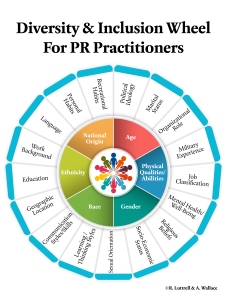To promote effective communication and growth of an organization, students learn to use the Diversity & Inclusion Wheel for PR Practitioners to think D/I at the inception of any assignment throughout the strategic planning process to evaluation and measurement which integrates the “Diversity-First Approach.” The goal is for students to learn to integrate a cross-cultural, multi-cultural approach to public relations aligned under one strategy.

The Diversity and Inclusion Wheel for PR Practitioners pictured here was developed with my co-researcher Adrienne Wallace from Grand Valley State University. This version of the wheel is based on work from Lee Gardenswartz and Anita Rowe DEI researchers. The model has been around since 1991 and has been modified repeatedly throughout the years.
Using the ROSTIR Model format, students can begin to formulate campaigns right from the start – research through reporting and evaluation:
- “Research:
- Perform research with publics, not just on publics; consider extra-organizational impact of goals.
- Work to become more aware of your own biases, considering how they might come into play in the specific campaign at hand.
- When soliciting participants for original research, ensure members are from heterogenous groups.
- Objectives:
- Consider why some audiences are targeted and not others, as well as how achieving objectives might impact diverse publics and stakeholders.
- Strategies:
- Develop messages and select channels with publics, not just for publics.
- Tactics:
- Review the diversity wheel and look for opportunities to include more representative examples, stories, images, and experiences in campaigns.
- Implementation:
- Monitor for unintended consequences; willingness to revise, update, and adjust tactics and messages as conversations and publics emerge and change.
- Reporting & Evaluation:
- Evaluate for social and community impacts. Segment reporting (how did the campaign impact a variety of audiences differently). If needed, communicate outcomes to diverse audiences inside and outside the organization.” (To cite, use: Public Relations Campaigns: An Integrated Approach, 2nd Ed.)
